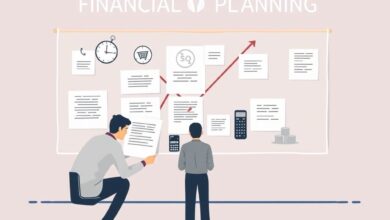Why every freelancer needs a financial safety net

Establish a dedicated savings account specifically for irregular income. This financial buffer should ideally hold at least three to six months’ worth of living expenses, providing peace of mind during lean periods. By segregating these funds from your regular spending, you can avoid the temptation to dip into them for everyday expenses.
Implement rigorous budgeting techniques that accommodate the unpredictable nature of self-employment. Track your monthly earnings and categorize your expenses meticulously. This practice will not only highlight spending patterns but also enable effective planning for future projects and potential dry spells.
Consider diversifying your income streams as part of your overall strategy. Engaging in multiple projects or offering various services can mitigate risks associated with dependency on a single source of revenue. Such foresight allows for better financial stability and encourages sustainable growth in your professional endeavors.
Regularly review and adjust your financial strategies based on market trends and personal circumstances. Staying proactive will empower you to adapt to changes swiftly, ensuring that your savings remain intact while you navigate the ups and downs of self-employment.
Understanding Income Variability
Establish a system to track your earnings meticulously. Irregular income can lead to unpredictable cash flow, making it essential for self-employed individuals to monitor fluctuations. Utilize spreadsheets or financial apps to record income sources, payment dates, and amounts received.
Create a flexible budget that accommodates varying income levels. Rather than relying on a fixed monthly expenditure, categorize expenses into needs and wants. Prioritize necessary costs such as rent, utilities, and groceries while adjusting discretionary spending based on available funds.
Set aside savings during high-income months. Allocate at least 20-30% of your earnings to a dedicated savings account during peak periods. This practice will provide a buffer in leaner times, ensuring that you can cover essential expenses without stress.
Consider diversifying your income streams. Relying solely on one source can exacerbate the impact of irregular payments. Explore different projects or side gigs that can supplement your primary work, thereby reducing overall income variability.
Regularly reassess your financial situation and adjust your budgeting strategy accordingly. Monitor trends in your earnings over time, identifying patterns that may help you anticipate future fluctuations. This proactive approach enables better planning and financial resilience.
Emergency Fund Calculation
Determine your target emergency fund by calculating three to six months’ worth of living expenses. Begin with a detailed breakdown of monthly costs, including rent, utilities, groceries, and insurance. Multiply the total by the number of months you aim to cover.
For example, if your monthly expenses total $3,000, an emergency fund for three months would be $9,000. Adjust this figure based on your unique circumstances; consider factors such as dependents or health conditions that could influence your financial needs.
Factor in income fluctuations when budgeting. Analyze your earnings over the past year to identify low periods. This assessment helps determine how much savings is needed to maintain stability during lean times.
Create a plan for accumulating these savings. Set aside a percentage of each payment received into a dedicated account for emergencies. Automate transfers to simplify this process and ensure consistent contributions.
Regularly review and adjust your calculations as income changes or expenses arise. Staying proactive ensures that your safety net remains adequate amid life’s uncertainties.
Budgeting for Unpredictable Months
Establish a baseline budget that accounts for your lowest income months. Analyze past earnings to determine an average monthly income, identifying peaks and troughs. This provides a solid framework for financial planning.
Create separate categories within your budget: fixed expenses (rent, utilities) and variable expenses (groceries, entertainment). Focus on minimizing variable costs during lean months while ensuring fixed costs are covered.
Implement the 50/30/20 rule tailored to irregular income: allocate 50% of your earnings to needs, 30% to wants, and 20% towards savings or debt repayment. Adjust these percentages based on actual earnings, prioritizing flexibility in your budgeting approach.
Track every expense diligently using apps or spreadsheets. This visibility helps identify spending patterns and areas where you can cut back if necessary. Regular reviews allow for adjustments in real-time.
Consider establishing a tiered saving strategy: maintain a minimum monthly savings amount but increase contributions during high-income periods. This creates a buffer that can be accessed during less lucrative months.
Plan ahead by forecasting potential dry spells based on seasonal trends in your industry. Prepare accordingly by building up reserves during peak times to cushion against inevitable downturns.
Evaluate subscription services and recurring expenses; cancel or pause non-essential services when facing lower income months. Prioritize essential tools that directly contribute to your earning potential as a self-employed individual.
Investing in Insurance Options
Prioritize obtaining health insurance tailored for self-employed individuals. This coverage protects against unforeseen medical expenses that can arise from accidents or illnesses, which are particularly burdensome when income is irregular.
Consider disability insurance as a critical component of your financial strategy. This policy ensures you receive income if an injury or illness prevents you from working, safeguarding your budget during tough times.
Look into liability insurance if your work involves client interactions or professional services. This coverage mitigates risks associated with potential lawsuits, preserving your finances from unexpected legal costs.
Explore options for business interruption insurance. If you’re running a small business and face interruptions due to external factors, this can help compensate for lost income, allowing you to maintain stability while planning your next steps.
Evaluate life insurance policies as part of long-term planning. Having this coverage provides peace of mind for loved ones should anything happen to you, ensuring they remain financially secure despite any disruptions in your earning capacity.
Regularly review and adjust your insurance policies based on changes in income and life circumstances. Effective budgeting means being proactive about these updates, aligning them with your current financial status and future goals.
Long-Term Financial Planning Steps
Begin with setting clear, achievable financial goals. Define specific targets for savings and investments that align with your lifestyle aspirations.
- Create a Detailed Budget:
- Track all sources of income and categorize expenses into fixed and variable.
- Adjust categories based on seasonal fluctuations in earnings.
- Establish a Savings Strategy:
- Set aside at least 20% of your income each month for long-term savings.
- Use high-yield savings accounts or investment vehicles to grow funds over time.
- Plan for Retirement:
- Contribute to retirement accounts such as IRAs or solo 401(k)s regularly.
- Aim to increase contributions as your income grows.
- Diversify Income Streams:
- Explore additional revenue opportunities, like freelance gigs or passive income options.
- This reduces reliance on a single source and stabilizes finances over the long term.
- Review and Adjust Regularly:
- Conduct quarterly reviews of your budget and savings plan to stay on track.
- Be prepared to modify goals based on changing circumstances or market conditions.
This structured approach ensures that you remain financially secure while pursuing self-employed ventures, adapting effectively to market realities and personal needs.







